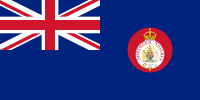Politics of Northern Nigeria
 |
| This article is part of a series on the politics and government of Northern Nigeria |
|
Constitution
|
|
|
Government
|
|
Legislature
|
|
Judiciary
|
The government of Northern Nigeria was modelled after the Westminister system. A premier acts as head of government and presides over the day-to-day affairs of government while a Governor acts as Head of state and Commander-in-Chief of the constabulary. The lower house of parliament called the House of Assembly is composed of elected representatives from the various provinces of the country. The Upper House of parliament called the House of Chiefs is similar to the British house of Lords. it is composed of unelected Emirs of the various Native Authority Councils of the nations provinces. Before 1963, the Queen of England served as the sovereign of Northern Nigeria.
Pre-Colonial Legacy
The structure of Northern Nigeria's governments is entwined in the administrative structure of the Sokoto Caliphate, In 1903, the Governor of Northern Nigeria; Lord Lugard guaranteed the administrative structure of the region when he decided to preserve the Emirate system of the Caliphate, in later structural adjustments the Emirates were slowly translated into provinces some of which became composed of multiple Emirates.
Northern Nigerianism
As opposed to Nigerian Nationalism, Northern Nigeria never experienced a phase of nationalism that usually preceded the independence of most African countries, Northern Nigerianism on the other hand was directed against the perceived dominance and influence of the Nigerian South.[1] In the 1940s the Northern Nigerian delegation opted to maintain Nigeria's federal structure and subsequently voted against Independence. In 1952 another rejection of Independence by the North led to attacks on the Northern Delegation to the Lagos conference; News of the attacks led to the 1952 Kano Riots and the famous "mistake of 1914" speech delivered by the sardauna.
In the 1970s organised Northern Nigerian activism slowly led to the emergence of powerful pan-northern interest groups, these groups were however severely decapitated by the sweeping victory's of Shehu Yar'adua Peoples Democratic Movement in 1993. since 1999, Northern Nigerianism has continued to sufferer electoral setbacks.
Administrative and Political Structures
Emirates
The Emir's of Northern Nigeria precise over the numerous Emirates of the country, their number has gradually grown since the introduction of sub-class emirates in the third and fourth Nigerian Republics. Although constitutionally nominal since the first republic, they continue to be a source of authority and influence throughout Northern Nigeria.[2] In 2014, the selection of Sunusi Lamido Sunusi as Emir Kano led to Four day standoff purportedly instigated by the president who was afraid of the influence that Sunusi will garner from the office.[3]
Local and State Governments
Local politics in Northern Nigeria has been plagued by kleptocratic interest groups since the fall of the Northern Central Government. Organised kleptocracies in the form family compact political groups usually rule the Northern Nigerian grass roots. Some have speculated that cultural influence of the Nigerian South could be responsible for the endemic corruption that is plaguing Northern Nigeria's political polity.[4]
References
- ↑ Bello, Ahmadu. youtube.com. youtube.com https://www.youtube.com/watch?v=_WSosECbcmM. Retrieved 2014-01-07. Missing or empty
|title=(help) - ↑ bbc.co.uk http://www.bbc.co.uk/news/world-africa-27740942. Missing or empty
|title=(help) - ↑ Muhammad, Abdussallam. "sunusi1". allafrica.com. Retrieved 2014-01-07.
- ↑ Kayode, Femi-Fani. premium times http://www.premiumtimesng.com/opinion/151053-nerve-lawal-kaita-shame-junaid-mohammed-femi-fani-kayode.html. Retrieved 2014-01-07. Missing or empty
|title=(help)